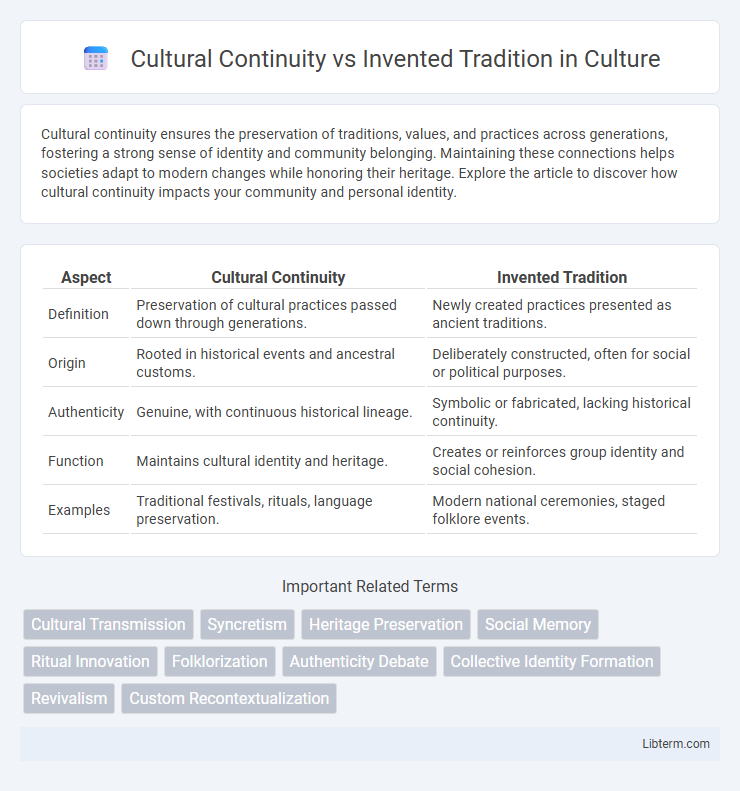Cultural continuity ensures the preservation of traditions, values, and practices across generations, fostering a strong sense of identity and community belonging. Maintaining these connections helps societies adapt to modern changes while honoring their heritage. Explore the article to discover how cultural continuity impacts your community and personal identity.
Table of Comparison
| Aspect | Cultural Continuity | Invented Tradition |
|---|---|---|
| Definition | Preservation of cultural practices passed down through generations. | Newly created practices presented as ancient traditions. |
| Origin | Rooted in historical events and ancestral customs. | Deliberately constructed, often for social or political purposes. |
| Authenticity | Genuine, with continuous historical lineage. | Symbolic or fabricated, lacking historical continuity. |
| Function | Maintains cultural identity and heritage. | Creates or reinforces group identity and social cohesion. |
| Examples | Traditional festivals, rituals, language preservation. | Modern national ceremonies, staged folklore events. |
Understanding Cultural Continuity: Definition and Significance
Cultural continuity refers to the unbroken transmission of cultural beliefs, practices, and values across generations, preserving a community's identity and heritage. It ensures social cohesion and stability by maintaining historical authenticity and collective memory within societies. Understanding cultural continuity is significant for recognizing genuine traditions, differentiating them from invented ones that may serve modern ideological or political purposes.
The Concept of Invented Tradition Explained
Invented tradition refers to practices or rituals deliberately created or formally established in recent times, often to serve social cohesion or legitimize institutions by fabricating a sense of historical continuity. These traditions, while presented as ancient or long-standing, are consciously constructed to instill collective identity, reinforce authority, or promote cultural values. The concept challenges the assumption that all traditions stem from unbroken historical transmission, emphasizing the role of invention in cultural practices.
Historical Roots: Tracing Genuine Cultural Practices
Historical roots provide a foundation for distinguishing cultural continuity from invented tradition by emphasizing authentic practices passed down through generations. Genuine cultural practices often exhibit consistent rituals, symbols, and values that can be traced back to specific historical contexts and communities. Scholars analyze archival records, oral histories, and material culture to verify the legitimacy of traditions and prevent the imposition of fabricated or modern reinterpretations.
Mechanisms of Cultural Transmission Across Generations
Mechanisms of cultural transmission across generations involve processes such as oral storytelling, ritual practices, and apprenticeship, which preserve cultural continuity by maintaining established norms and values. Invented traditions emerge through deliberate reinterpretation or fabrication of customs to create a sense of historical depth and social cohesion, often relying on formal education or state endorsement to disseminate new narratives. Both mechanisms shape identity by embedding symbolic meanings within practices that evolve dynamically, balancing preservation with innovation in cultural heritage.
Case Studies: Real-World Examples of Invented Traditions
Invented traditions often emerge as deliberate constructs to foster national identity or social cohesion, as seen in the Scottish tartan revival of the 19th century, which crafted a unifying symbol despite its limited historical continuity. Similarly, the Japanese tea ceremony, while rooted in older practices, was systematized in the Edo period to promote cultural values aligned with contemporary political agendas. These case studies highlight how invented traditions serve strategic purposes by embedding selective historical narratives into modern cultural practices.
Motivations Behind Creating New Traditions
The motivations behind creating new traditions often stem from a desire to forge a collective identity, legitimize social or political power, and foster social cohesion within evolving communities. Invented traditions serve strategic functions by providing symbolic continuity with a selective interpretation of the past, even when such practices are recent constructions. These motivations reflect underlying cultural, ideological, and pragmatic needs that prioritize stability and purpose in periods of change or uncertainty.
Authenticity vs. Adaptation: Blurred Lines in Modern Culture
Cultural continuity preserves authentic practices passed down through generations, while invented traditions emerge as adaptive responses to contemporary needs, often blending historical elements with new interpretations. The blurred lines between authenticity and adaptation challenge fixed definitions, highlighting how modern culture dynamically negotiates identity by reshaping tradition. This interplay influences societal values, heritage conservation, and the evolution of communal narratives in a globalized world.
Societal Impacts: Uniting or Dividing Through Tradition
Cultural continuity preserves existing social bonds by reinforcing shared histories and practices, fostering a cohesive community identity. Invented traditions can either unite groups by creating new collective symbols or divide societies when imposed without genuine historical roots, causing cultural tensions. Societal impacts hinge on authenticity and inclusivity, where genuine traditions enhance solidarity while fabricated ones risk alienation and conflict.
The Role of Authority and Institutions in Shaping Traditions
Authority and institutions play a pivotal role in shaping traditions by legitimizing and standardizing practices that may either stem from genuine cultural continuity or be newly created to serve specific social or political objectives. These entities often codify rituals, symbols, and narratives, embedding them within collective memory to establish a sense of historical authenticity and social cohesion. The power dynamics within institutions directly influence whether traditions are preserved authentically or strategically invented to reinforce identity, control, or ideological agendas.
Navigating the Future: Preserving Continuity or Embracing Change
Navigating the future requires balancing cultural continuity with the invention of tradition, where preserving ancestral customs safeguards identity while embracing adaptive innovations fosters societal resilience. Scholars emphasize that maintaining core cultural narratives strengthens communal bonds, whereas strategically inventing traditions can address contemporary challenges and promote inclusivity. Effective cultural stewardship involves dynamic negotiation between honoring heritage and integrating evolving values for sustainable cultural vitality.
Cultural Continuity Infographic

 libterm.com
libterm.com